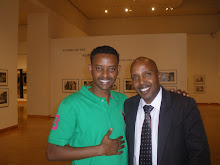
By Maria Sacchetti
Wednesday, August 12, 2009
Until this year, 14-year-old Burhan Ali could hardly speak to his mother.
His mother, a refugee from Somalia, would scold him in her native tongue, and Burhan would fume silently. For the American-born teenager, it was living “like I’m on mute.’’
They were mother and son, separated by one language: Somali.
But that has been changing in the past few weeks. Every morning, Burhan has voluntarily studied his mother’s language as part of a six-week summer program in Boston that offers youths jobs and free classes.
For Somali-Americans, it is a chance to recapture a dying language that was only written down for the first time in the early 1970s and is rapidly being overtaken by English and other languages. It is also bringing youths closer to their parents and to their culture.
“The language is tied with the culture, which is tied with the history,’’ said Abdulkadir Y. Hussein, founder and chief executive of the African Community Economic Development of New England, which is running the program for about 80 children and youths ages 6 to 18. “If the language dies, then the culture dies and then your history dies, too.’’
It is an issue that advocates say has only grown in importance in the past year amid concerns that disengaged Somali youths in the United States, particularly in Minnesota, may be joining militant groups in their homeland.
Advocates for Somalis, who have said they have not heard of such recruitment in the Boston area, say the classes seek to build students’ confidence and self-esteem by connecting them to their history and their families, which can help them in all areas of life, from avoiding extreme behavior to succeeding in school.
Shirwa Hassan of Scansom Publishers, a Toronto-based Somali publishing house that participated in the Boston-area’s first Somali book fair last month, said Somali is a poetic, nuanced language of a mostly nomadic people, who confronted drought, lack of food, and civil war.
The language of the nation on the Horn of Africa was exclusively oral until the early 1970s. The alphabet is Latin, but is pronounced like Arabic. It is so new that only about 250 Somali books exist, and they are mostly distributed outside Somalia.
In Somalia, barely 38 percent of the population can read or write, according to the US State Department. About 5,000 Somalis and Somali-Americans live in the Boston area.
One day last week, in an airy classroom with yellow walls in a Roxbury community center, eight boys and girls huddled over workbooks in Somali and English, learning grammar, vocabulary, history, and culture. The scratchy roar of an air conditioner filled the room.
The teacher, Ardo Mohamed, dressed in a long skirt and head scarf, started with a game between boys and girls: Name a word that starts with an M.
They easily called out words: Marti (guest). Maayliyid (wealth). Maya (no).
But they struggled with other exercises.
“What does dugsiyada mean?’’ Mohamed asked.
“Mosque?’’ one student ventured.
“No,’’ she said, “schools.’’
“How many of you are understanding this?’’ the teacher asked.
Some smiled sheepishly.
“I am,’’ said an 18-year-old student, Mohamed Abdullahi, with a smile.
In this room, the Somali-American teenagers fit in perfectly, with the girls dressed in head scarves and long, modest skirts. But in regular schools, the girls’ garb can stand out, and the Somali-Americans are in many ways very different from other students. Their parents speak a different language, come from a different country, and worry about different things.
Their parents are consumed with worry about their homeland, which is still run by a transitional government and struggling to recover from the civil war and deal with militant insurgencies. Family members back home increasingly depend on the money sent by relatives in the United States.
For the children of immigrants, even those who were born in refugee camps, the issues can often seem distant. Despite cultural differences, especially in the girls’ clothing, many often blend easily in America, with their Nike sneakers and flip-flops and impeccable English.
But they also grow distant from their parents, partly because of language, which is one of the main reasons several students signed up for the class.
“It’s an embarrassment not to know your language,’’ said Said Said, 14, who gets double-takes about his name, except here.
Ayan Abdullahi, 16, wanted to improve her Somali to better communicate with her grandmother, who nags her to eat more because she thinks she is too skinny. Until now, Ayan could say little in return.
“I can say a whole sentence in Somali now,’’ she said. “I usually would put in English words, and my grandmother would say, ‘I don’t know what you’re talking about.’ ’’
Until he began the classes, Burhan Ali had relied on his sister to translate between him and his mother, which often worked against him. Once, she broke a cup and blamed him for it.
“I couldn’t say anything about it,’’ he said, still upset.
But now, he surprises his mother when they settle in to watch the news. His mother is desperate to know what is going on in the world, but understands little of the newscast.
“Now, I can actually tell her what the news is about,’’ he said, a warm smile going across his face. “She thinks it’s wonderful. She says she loves it.’’
As for his sister, “she doesn’t like it that much,’’ he said with a laugh.
Source: Boston Globe, August 12, 2009

















































